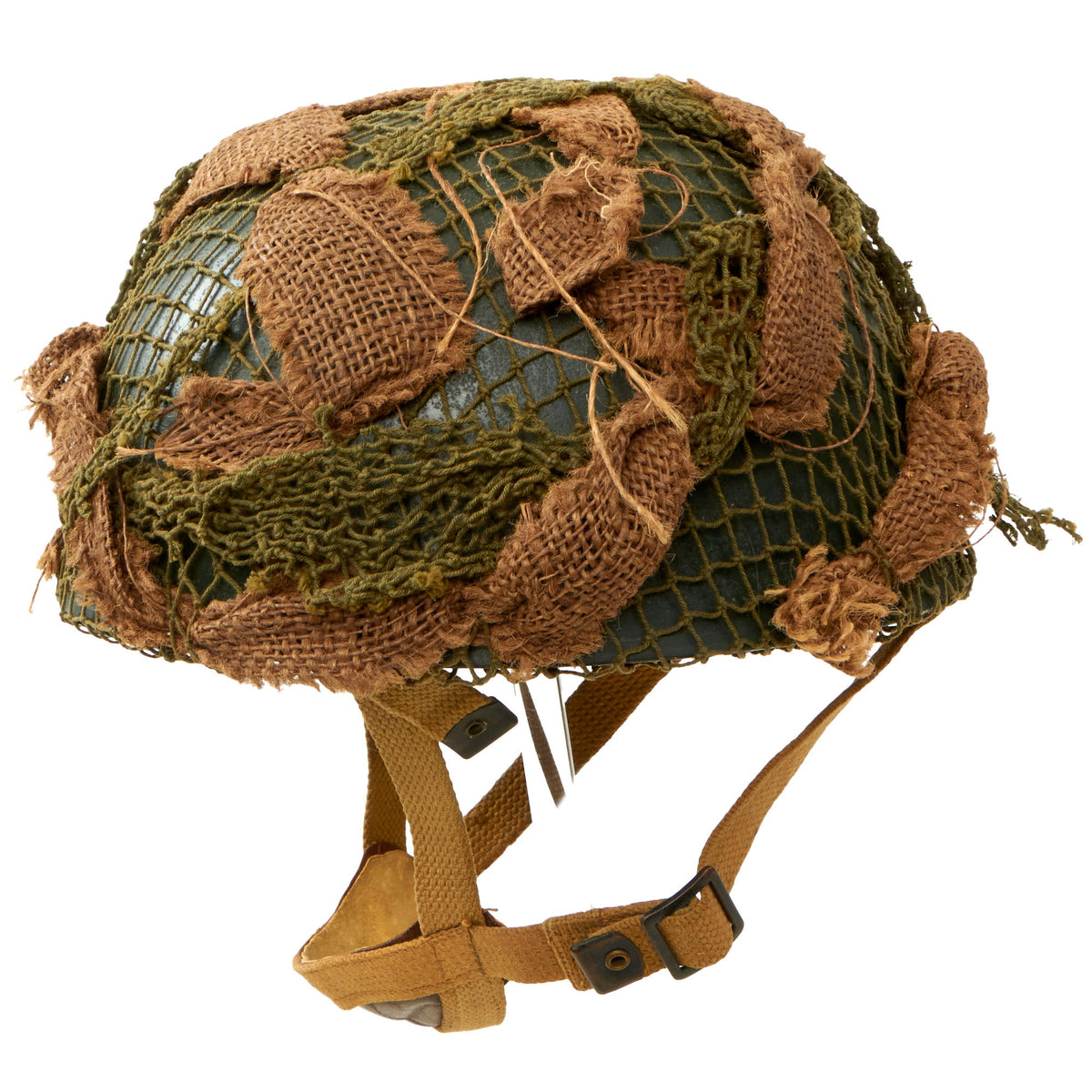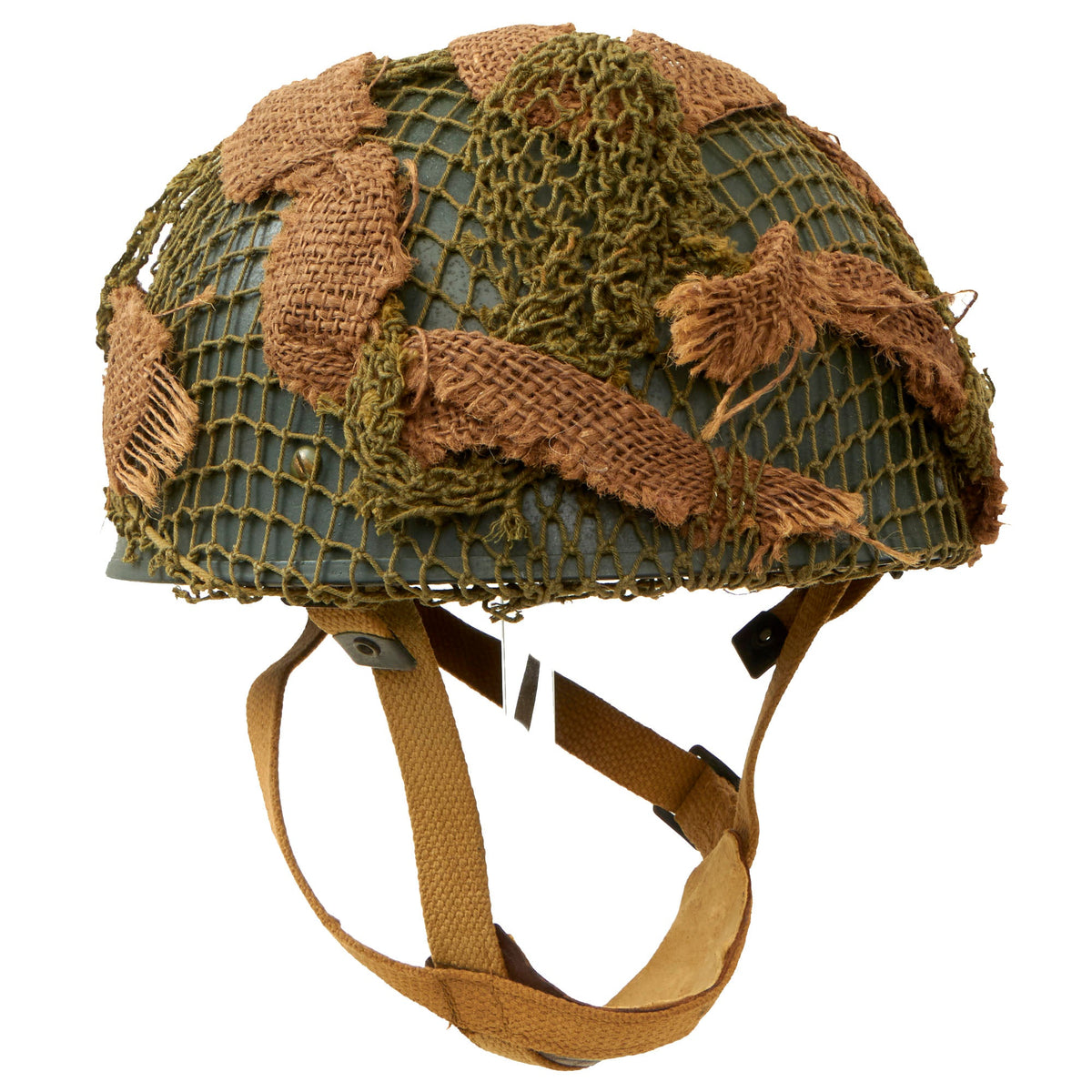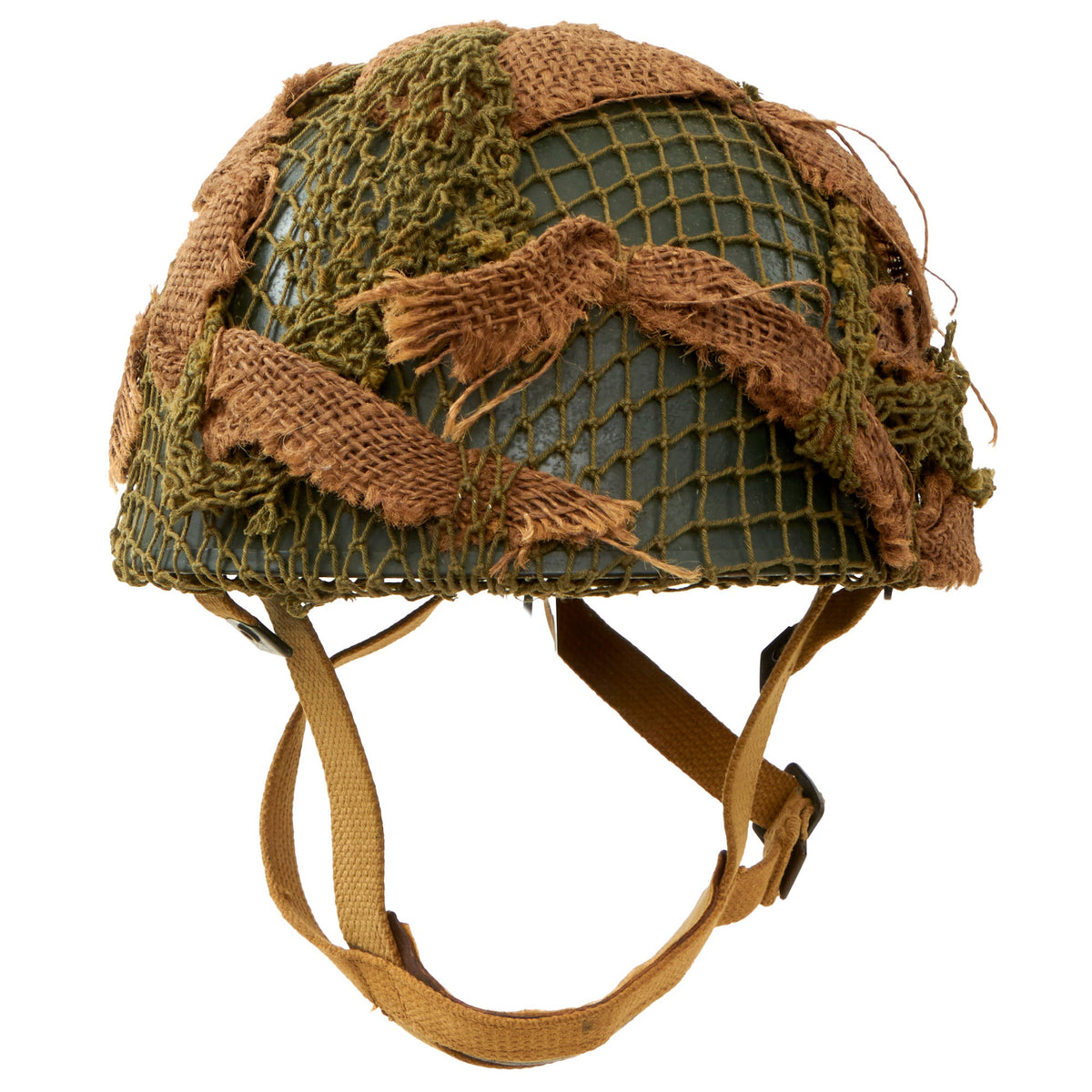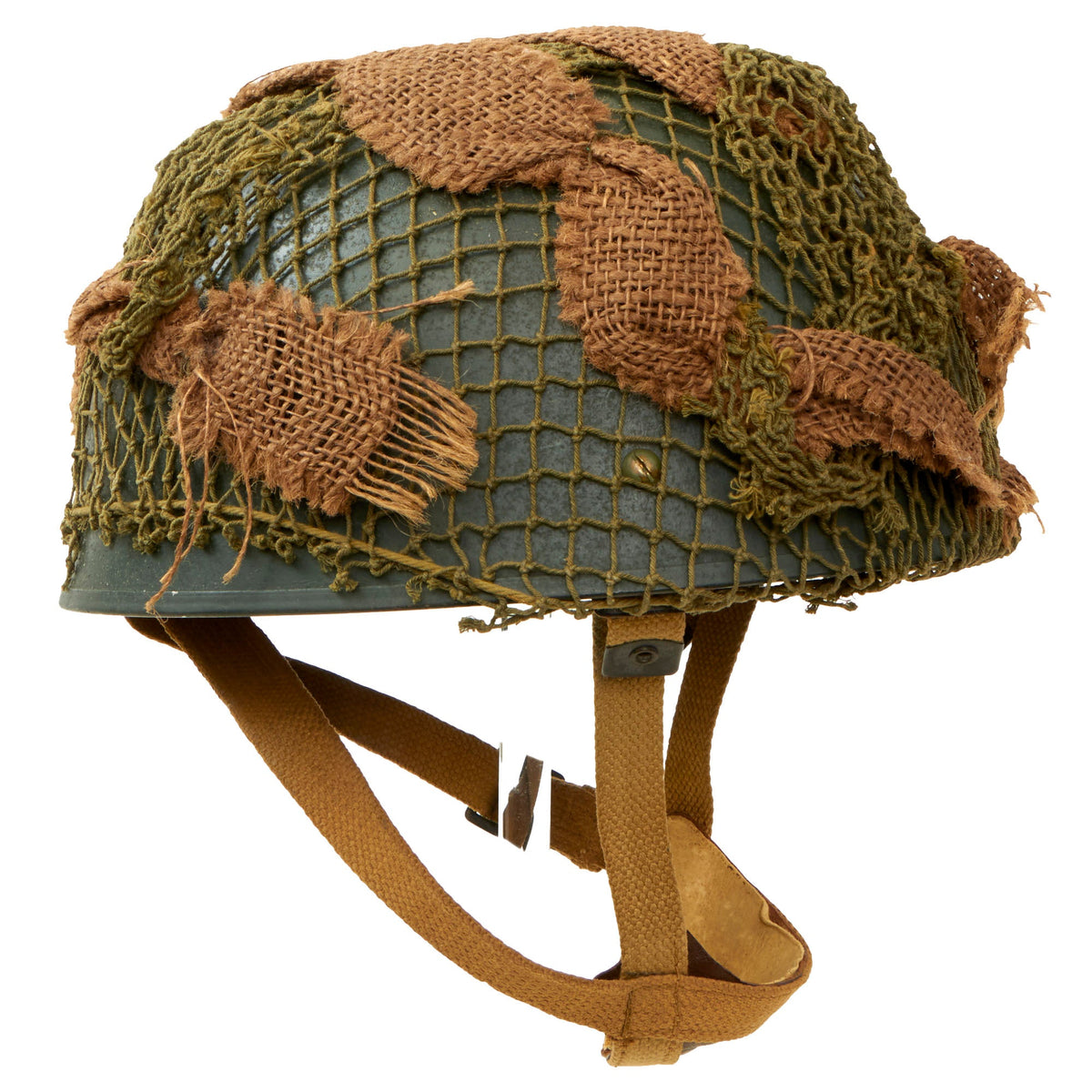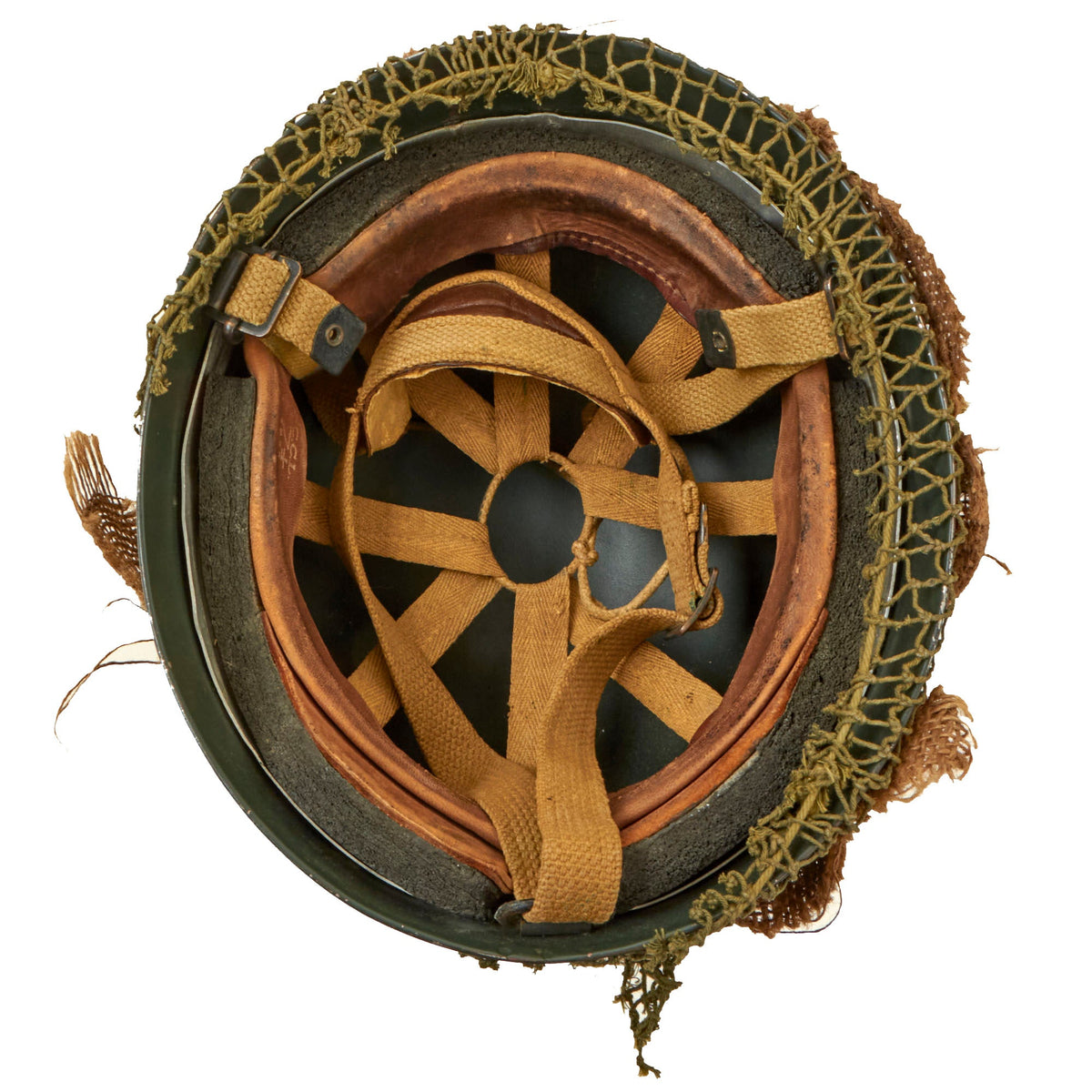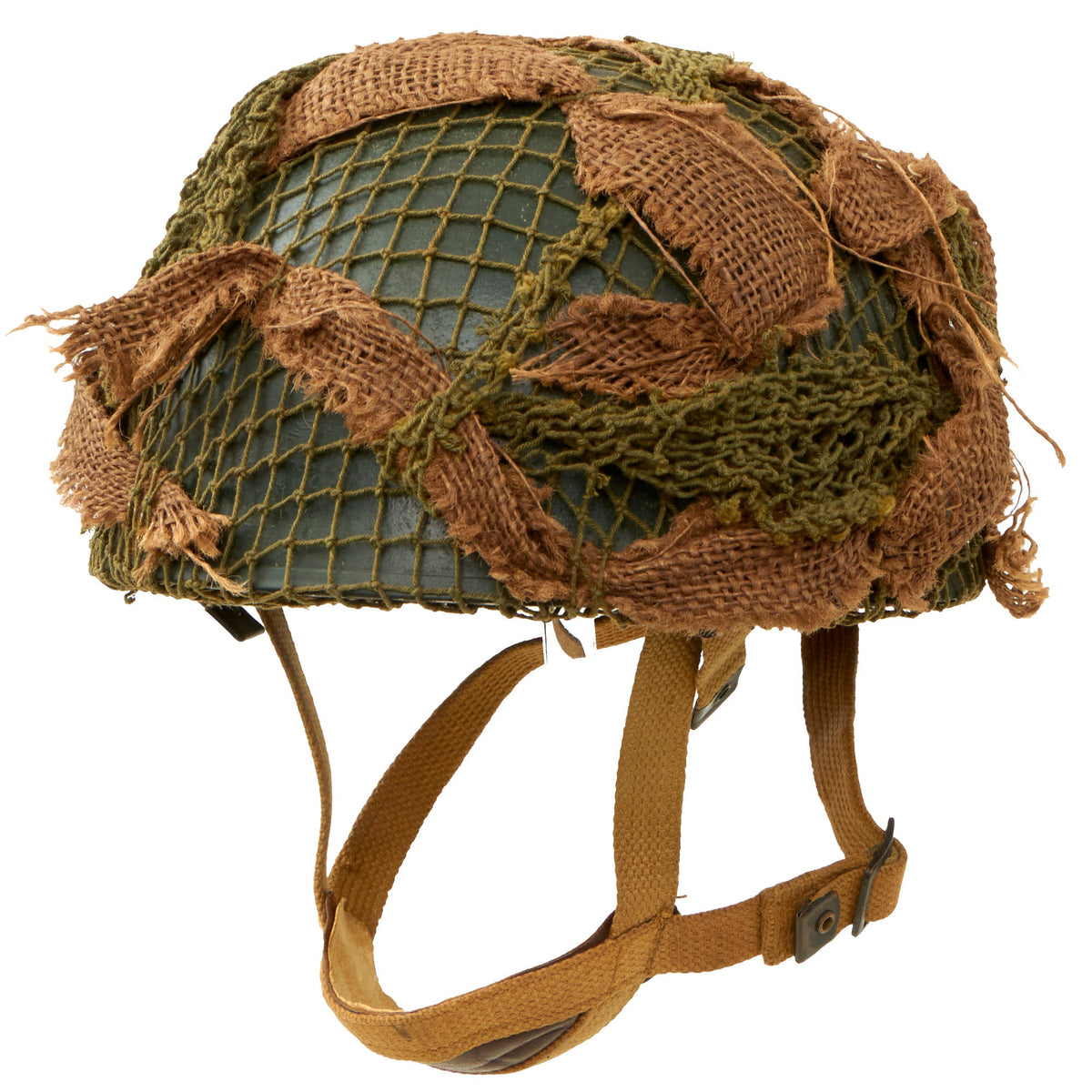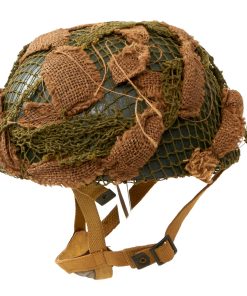Original British Suez Crisis Operation Musketeer Era MKII HSAT Paratrooper Helmet With Camouflage Netting – 1955 Dated Original Items
$ 495,00 $ 148,50
Original Item: Only One Available. Now this is a fantastic example of the “Helmet, Steel, Airborne, Troops” HSAT MKII British Paratrooper helmet. The helmet is stamped with ROC for production by Rubery Owen & Co, a well known maker of these helmets. This example has a gorgeous period camouflage net with integrated burlap. There also appears to be a name written on the liner, making this an intriguing research project!
Operation Musketeer was the Anglo-French plan for the invasion of the Suez canal zone to capture the Suez Canal during the Suez Crisis in 1956. The operation had initially been given the codename Operation Hamilcar, but this name was quickly dropped when it was found that the British were painting an air recognition letter H on their vehicles, while the French, who spelled Hamilcar differently, were painting an A. Musketeer was chosen as a replacement because it started with M in both languages. Israel, which invaded the Sinai peninsula, had the additional objectives of opening the Straits of Tiran and halting fedayeen incursions into Israel. The Anglo-French military operation was originally planned for early September, but the necessity of coordination with Israel delayed it until early November. However, on 10 September British and French politicians and Chiefs of the General Staff agreed to adopt General Charles Keightley’s alterations to the military plans with the intention of reducing Egyptian civilian casualties. The new plan, renamed Musketeer Revise, provided the basis of the actual Suez operation.
This wonderful rare example helmet has some minor wear but is in a large size 7 ⅛. The liner is nicely marked:
CCL
7¼
1955
CCL is the marking for Christy & Co Ltd London, a well known manufacturer of crafted hats and clearly helmet liners. Since its founding in 1773, Miller Christy’s passion for impeccable quality and skilled craftsmanship has passed through generations of hatmakers, safeguarding Christys’ red and gold insignia as a symbol synonymous with fine traditionally crafted hats. Official helmet manufacturer of the UK Police Force for two centuries, Christys’ stands as the Godfather of British hatmaking – not least since its Homburg hat was worn by Marlon Brando’s Don Corleone. The cult of Christys’ is recognisable throughout cinema, fashion, music and politics, amassing an eclectic lineup of wearers from Winston Churchill to Kate Moss, Indiana Jones to Brad Pitt. Christys’ was and is a brand with an eye on the future and, while methods have remained largely unchanged and heritage is paramount, it is the capacity to transcend trends and social borders that makes Christys’ hats as sought after as ever.
The chinstrap and leather cup are present and in great condition. The helmet retains nearly all of its original factory applied exterior paint. What makes this helmet truly exceptional is the camouflage net with integrated burlap over the helmet, most likely done for this Operation Musketeer.
This helmet is in excellent museum-quality condition, and would make an excellent addition to any collection! Comes ready for further research and display.
Operation Musketeer
Headed by British Army General Charles Keightley, it was conducted in November 1956 in close coordination with the Israeli armoured thrust into the Sinai, which was called Operation Kadesh. Egypt’s government, led by Colonel Gamal Abdel Nasser, was seeking political control over the canal, an effort resisted by the Europeans. The army was originally to land at Alexandria, but the location was later switched to Port Said since a landing at Alexandria would have been opposed by most of the Egyptian army, necessitating the deployment of an armoured division. Furthermore, a preliminary bombardment of a densely populated area would have involved tens of thousands of civilian casualties. The naval bombardment of Port Said was rendered less effective by the decision to only use 4.5-inch guns instead of large caliber guns, in order to minimise the number of civilian casualties.
The final land order of battle involved the Royal Marine Commando Brigade, the 16th Parachute Brigade, and the 3rd Infantry Division. To bring these formations to war establishment, the regular army reserve and selected national service reservists were mobilised. Most of the latter were sent to units in home stations (Britain and Germany) to replace regulars posted to the Musketeer force. Lieutenant General Sir Hugh Stockwell was appointed to command the landing force. A French parachute brigade joined 16th Parachute Brigade as it returned to Cyprus. The Commando Brigade completed refresher training in shore landings from helicopters, in association with the Mediterranean fleet, which was preparing to support the amphibious operation. Over the summer the Royal Air Force selected a range of targets whose loss would cripple Egyptian resistance.
Details of the secret plan for Israeli forces to invade the Sinai desert were revealed to the Chiefs of the Defence staff in October. On 29 October Israeli armour, preceded by parachute drops on two key passes, thrust south into the Sinai, routing local Egyptian forces within five days. Affecting to be alarmed by the threat of fighting along the Suez Canal, the UK and France issued a twelve-hour ultimatum on 30 October to the Israelis and the Egyptians to cease fighting. When, as expected, no response was given, Operation Musketeer was launched.
The air offensive began. The 3rd Division, minus the Guards Brigade, embarked on 1 November. The 45th Commando and 16th Parachute Brigade landed by sea and air on 5 November. Although landing forces quickly established control over major canal facilities, the Egyptians were able to sink obstacles in the canal, rendering it unusable. The Anglo-French air offensive suppressed Egyptian airfields not already attacked by the Israelis, but failed to destroy oil stocks or cripple the Egyptian army.[5] Cairo Radio continued to broadcast. The 3rd Battalion Parachute group captured El Cap airfield by airborne assault. The remaining units, held back initially for deep airborne targets, travelled by sea to Port Said. The Commando Brigade captured all its objectives. The French parachutists took Port Fuad, opposite Port Said. Elements of the 16th Parachute Brigade led by Brigadier M.A.H. Butler and a contingent of the Royal Tank Regiment set off south along the canal bank on 6 November to capture Ismailia.
Fast Shipping with Professional Packaging
Thanks to our longstanding association with UPS FedEx DHL, and other major international carriers, we are able to provide a range of shipping options. Our warehouse staff is expertly trained and will wrap your products according to our exact and precise specifications. Prior to shipping, your goods will be thoroughly examined and securely secured. We ship to thousands clients each day across multiple countries. This shows how we're dedicated to be the largest retailer on the internet. Warehouses and distribution centres can be located throughout Europe as well as the USA.
Note: Orders with more than one item will be assigned a processing date depending on the item.
Before shipping before shipping, we'll conduct a thorough inspection of the items you have ordered. Today, the majority of orders will be delivered within 48 hours. The delivery time will be between 3-7 days.
Returns
The stock is dynamic and we cannot completely manage it because multiple stakeholders are involved, including our factory and warehouse. So the actual stock may alter at any time. It's possible that you may not receive your order once the order has been made.
Our policy is valid for a period of 30 days. If you don't receive the product within 30 days, we are not able to issue a refund or an exchange.
You can only return an item if it is unused and in the same state as the day you received it. You must have the item in its original packaging.
Related products
Uncategorized
Uncategorized
Uncategorized
Uncategorized
Uncategorized
Uncategorized
Angolan Rebel 1970s era 60mm Inert Display Mortar from Angolan Civil War Original Items
Uncategorized
Uncategorized
Uncategorized
Uncategorized
Uncategorized
Armoured Fighting Vehicles of the World: AFVs of World War One (Hardcover Book) New Made Items
Uncategorized
Uncategorized
Uncategorized
Uncategorized
Uncategorized
